The World Health Organisation (WHO) recently included Traditional Chinese Medicine into its global medical compendium, thus recognising that dried and powdered bits of rare and endangered animals can cure all possible ailments and diseases. But of course Modern Medicine remains valid also, and in fact the WHO’s International Agency for Research on Cancer (IARC), with its seat in Lyon, France, uses modern technologies to find new cancer therapies. One such digital technology, applied very efficiently all very the world, is based on Photoshop, where images of western blots and other research data get artistically modified to facilitate the publishability of the postulated cancer therapy ideas in respected peer reviewed research journals. It does not really help cancer patients, but the beneficial effect on the academic and industry careers of such scientists is extremely significant and has been extensively validated and reproduced over the years.
The cancer researchers at WHO whose papers contain such impressive manipulations, are Massimo Tommasino, head of Infections and Cancer Biology Group at IARC, and his former junior colleague there Uzma Hasan, now tenured group leader at INSERM in Lyon. Some of their best or worst papers (depending how you judge it) were authored together with an industrial researcher, Jaromir Vlach, working for the Schering-Plough Research Institute which was eventually taken over by the German pharma giant Merck (known in USA as EMD).The evidence was posted on PubPeer by anonymous commenters, one of whom was the pseudonymous Clare Francis, who also alerted me to that case.
Update 3.12.2019: WHO now pronounced that their investigation:
“Found no evidence of scientific misconduct and concluded that the allegations made on PubPeer are not adequately supported and are therefore unfounded”
This was for example what Hasan, Tommasino and Vlach published on the topic of immune system responses, in the elite journal PNAS, Hasan et al 2007:
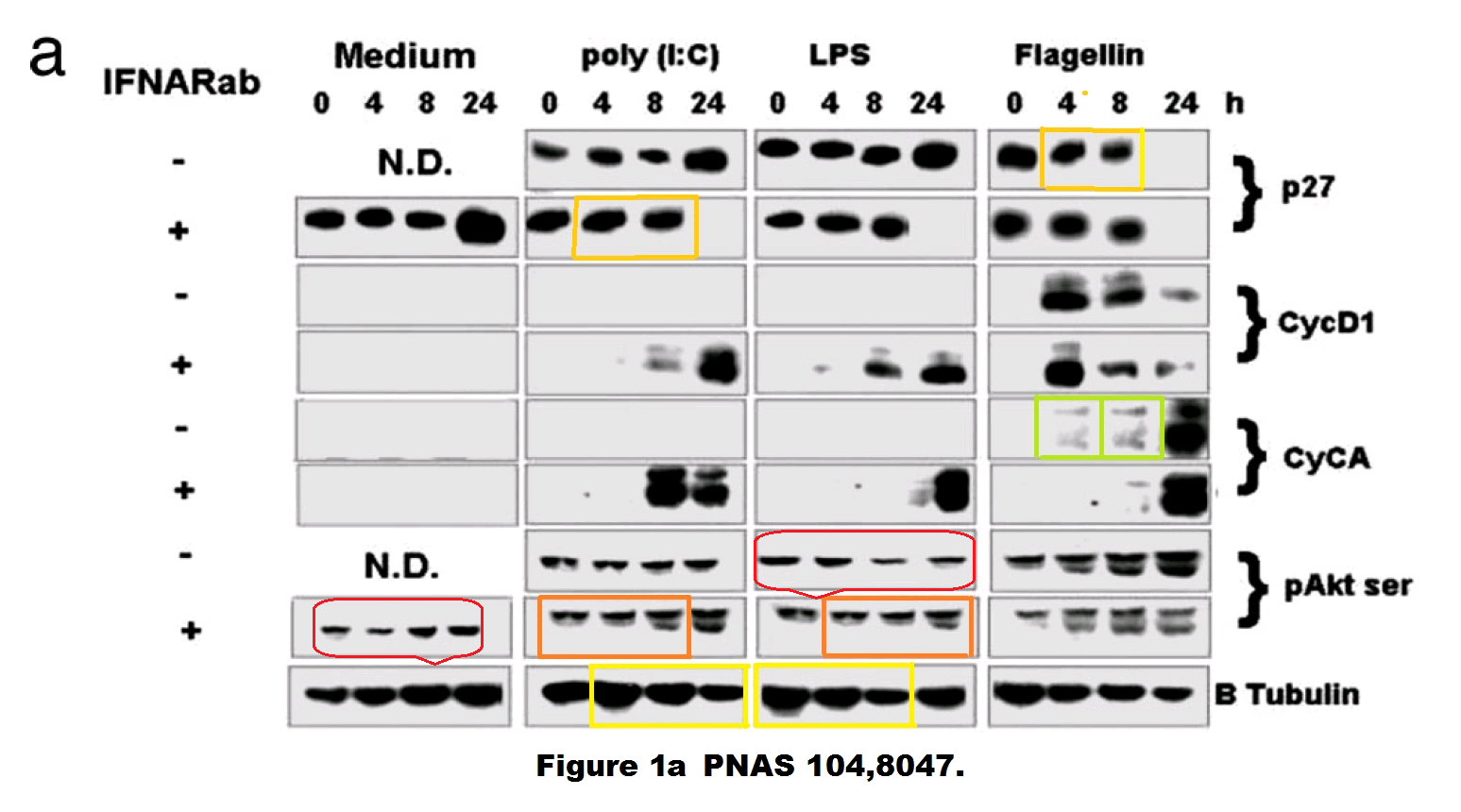
This figure contains a plethora of duplicated gel bands, so much that it is actually almost funny. Who is responsible, we do not know. The contributions say that Tommasino only contributed “new reagents/analytic tools”, while research was designed by Vlach and the two first authors. The first and corresponding author Hasan was at that time already in Tommasino’s IARC department for Infections and Cancer Biology. That PNAS paper of hers contains many other examples of Photoshop activities, like this Figure 5 here:
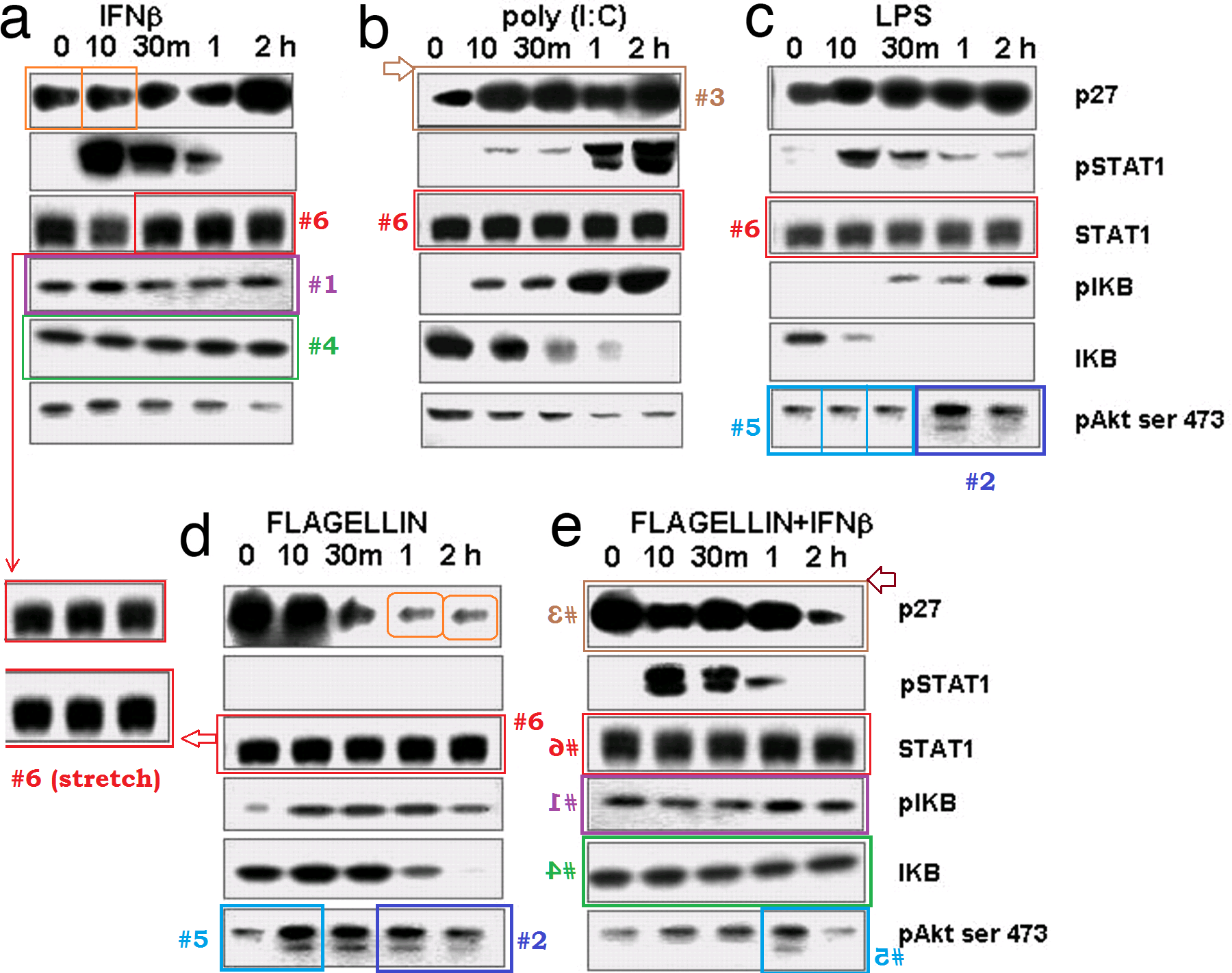
The industry researcher Vlach is the last author and the project designer, but it seems the work was done at IARC, since that this Photoshop tour de force was publicly funded:
“This work was supported by grants from La Ligue Contre le Cancer (Comité de Savoie) and the grant “Applied Tumour Virology” German–French cooperation, German Cancer Research Center (DKFZ), Heidelberg–Cancéropôle du Grand-Est, Besançon.”
The afore-ridiculed Figure 1A of Hasan et al PNAS 2007 contains elements which previously appeared in a different context, in a different paper and likely also in a different lab where Hasan worked until 2005, at Schering-Plough with Vlach (Hasan et al JBC 2005):
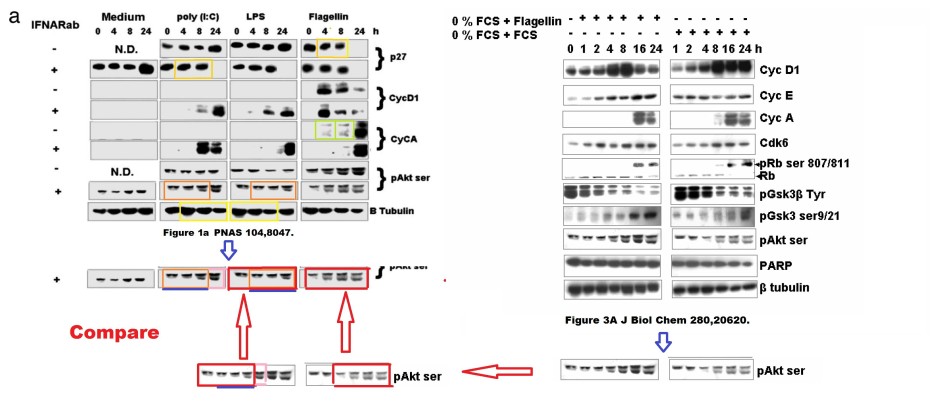
That 2005 paper appeared in the Journal of Biological Chemistry, which is known to be tough on data manipulation, might become a problem for this paper’s three authors. Good for Tommasino that he is not one of them. There is even a duplicated flow cytometry measurement, quantified slightly differently, maybe to obscure similarities.
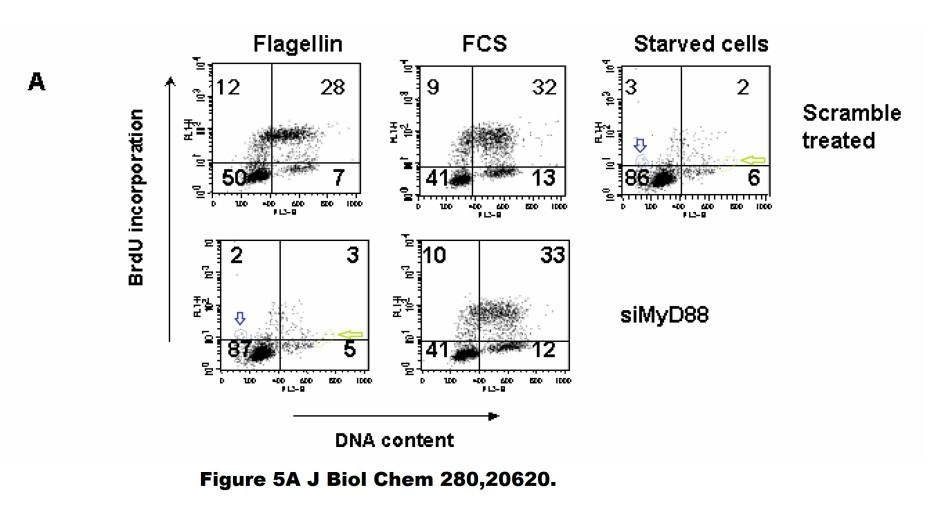
Also this Hasan et al JBC 2005 study contains more of creative tricks which helped the authors elucidate the molecular pathway of Toll-signaling in immune cells. Who knew it happens through post-experimental digital data duplication?
Hasan’s work at Schering-Plough before her move to IARC with Tommasino was truly productive. Look at this interesting figure from Hasan et al J Immunology 2005:
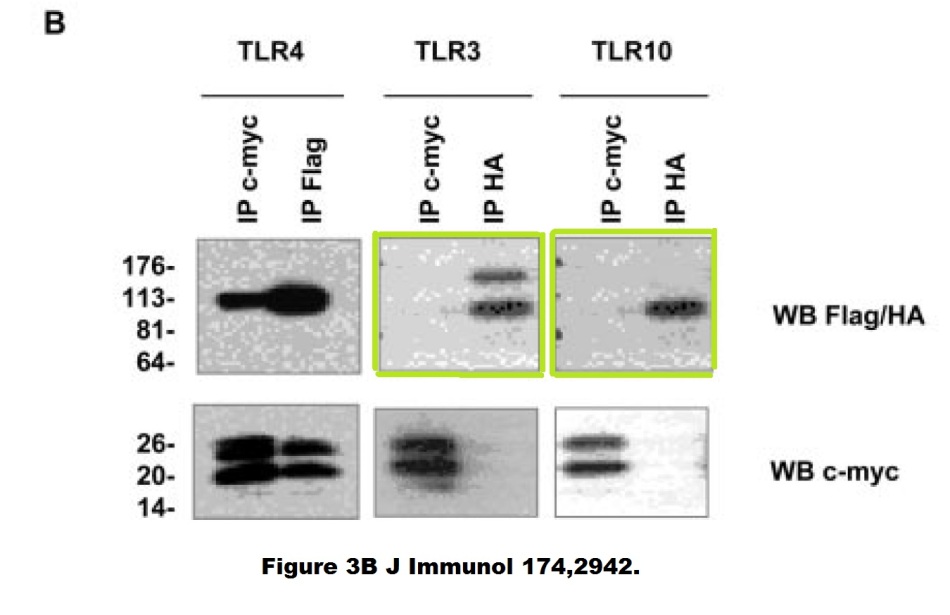
The framed western blot two images for Flag/HA are very similar, except the upper gel band. How can this be? Can someone accidentally reuse same image twice, while accidentally erasing the top band in one of them? There is more to find in that paper also. Tommasino is not coauthor, but is credited with having provided “invaluable advice on this manuscript”, just like in the other Hasan et al JBC 2005 paper from Schering-Plough, now part of Merck.
With Tommasino as last author, but now without Vlach and his pharma industry input, Hasan authored same year 2007 this paper, Hasan et al J Immunology 2007. Also here, Hasan is corresponding author. This IARC study helped us understand how cervical cancer develops and offered “future promise for the prevention of infectious diseases, cancer, and autoimmune diseases“. This is how this promise works, and this is just one example from that paper:

Apparently, by re-using certain western blot bands, a potential prevention therapy for cervical cancer can be established. Amazing research, done by WHO scientists at IARC, with public support:
“The study was supported by grants from La Ligue Contre le Cancer (Comité de la Savoie), “Applied Tumour Virology” German-French cooperation, and Deutsches Krebsforschungszentrum-Cancéropôle du Grand-Est.”
2007 was a particular year in Tommasino’s IARC lab, with a particularly rich harvest of Photoshopped papers in prestigious journals. Also this paper features Hasan as one of coauthors, Mansour et al, Virology 2007., Tommasino is the corresponding author. The study offers insights into mechanisms of cervix cancer progression and suggests how this cancer can be early detected. This is how the clinical approach would work:

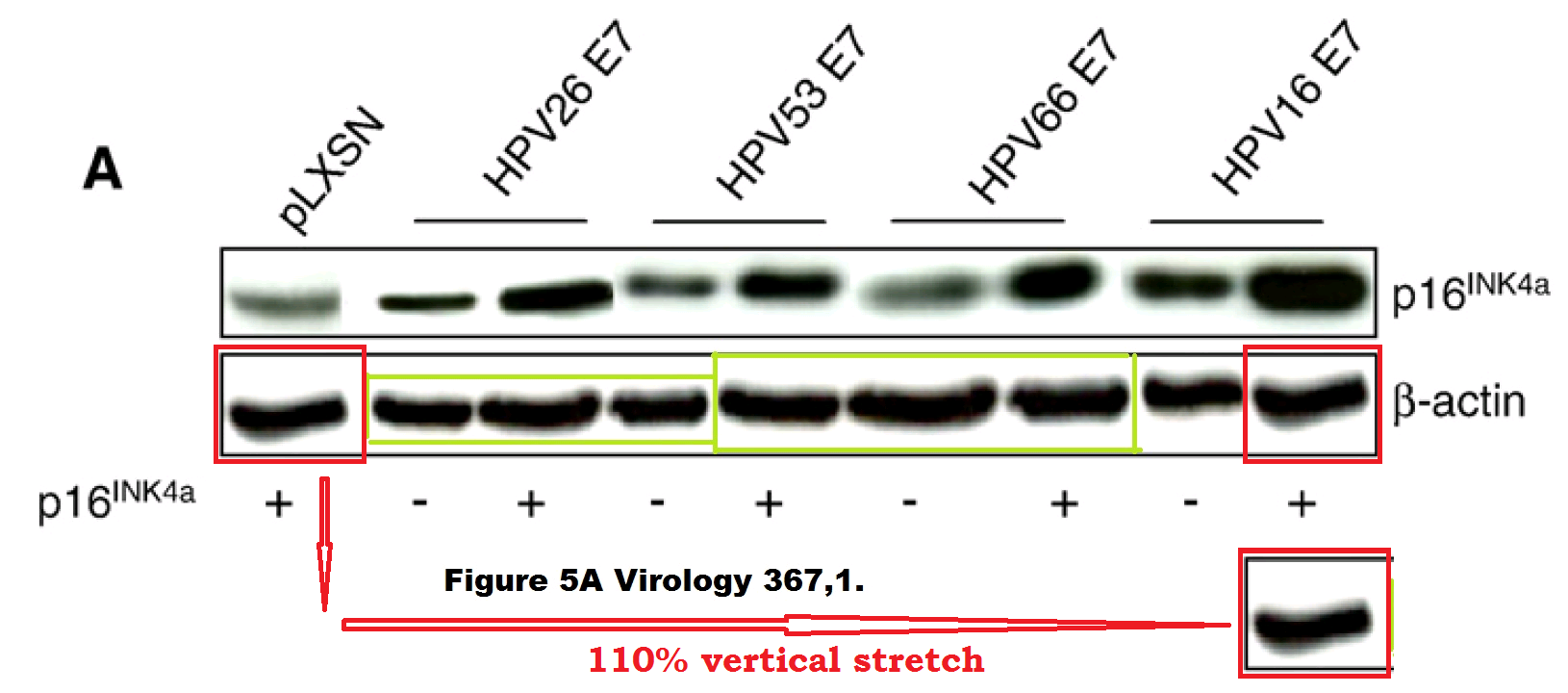
Female patient at risk of cervical cancer will be asked to sit upon the printout of these Photoshopped western blot images, or other examples from that paper. Any resident cervical cancer cells inside the patient will be appalled by such pathetically crude data manipulations of loading controls and die in shame. In case you wonder, why some authors need to manipulate such allegedly unimportant bits of the figure like loading controls: it’s probably because the correct loading controls would have rendered the entire figure as useless or even fraudulent. Hence, cancer is being attacked not with science, but with Photoshop. This is probably exactly what EU Commission had in mind when funding this travesty :
“The study was partially supported by grants from European Union (LSHC-2005-018704) Deutsche Krebshilfe (grant N. 10-1847-To I), and Association for International Cancer Research to MT and a grant from La Ligue Contre le Cancer (Comité du Rhône)”
Tommasino never had a high opinion of loading controls anyway, it seems he saw them as nuisance and tried to make a point of this by publishing such ridiculously Photoshopped stuff. Who is interested in how much sample was loaded where, if the end picture of signal differences and its scientific message is what matters? Nobody, that’s WHO. This is why we find in older Tommasino papers figures like this, in Malanchi et al 2004 or Giarre et al 2001, both passed peer review in Journal of Virology:
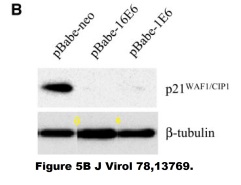
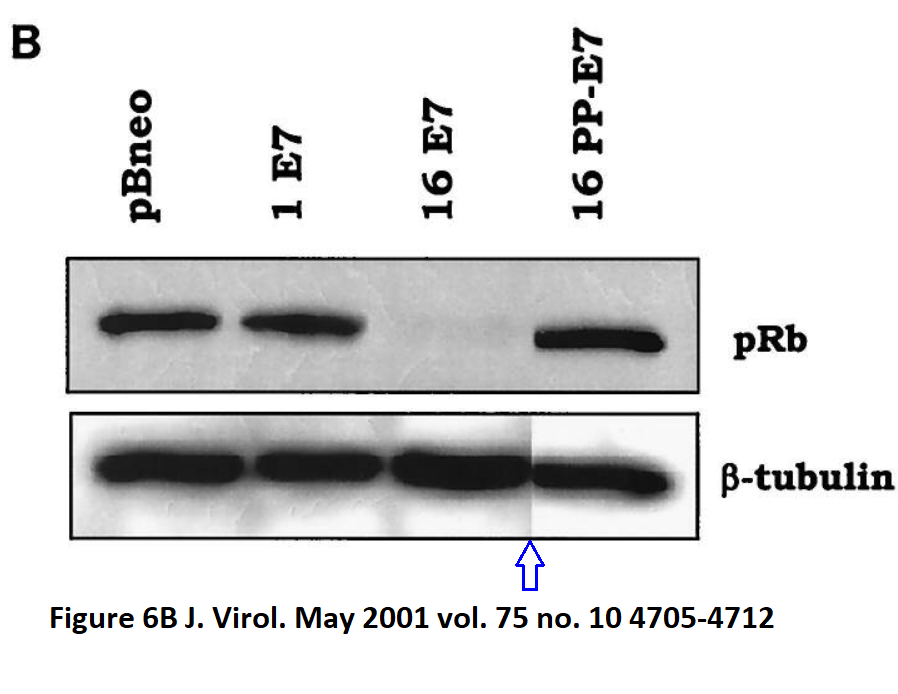
Unfortunately such attitude to research integrity in Tommasino’s department at IARC is not ancient history. The following comes from two relatively recent papers from that lab, Shahzad et al J Virology 2013 and Siouda et al PLOS Pathogens 2014:
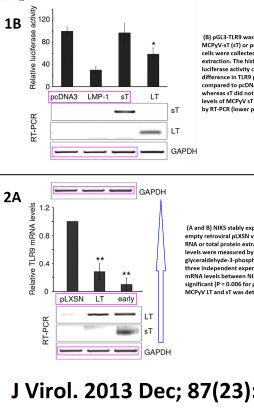
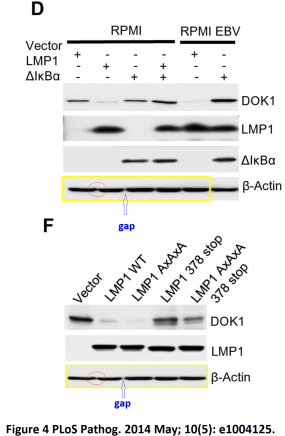
We learn that viruses play a key role in carcinogenesis, and the correct way to clinically intervene on viral infection to prevent cancer is to reuse loading controls for various experiments, to placate some pesky peer reviewers.
Even the EMBO fellow and newly minted INSERM group leader Dr Hasan was back at publishing copy-pasted cancer therapy ideas, at Journal of Experimental Medicine, Hasan et al, JEM, 2012:
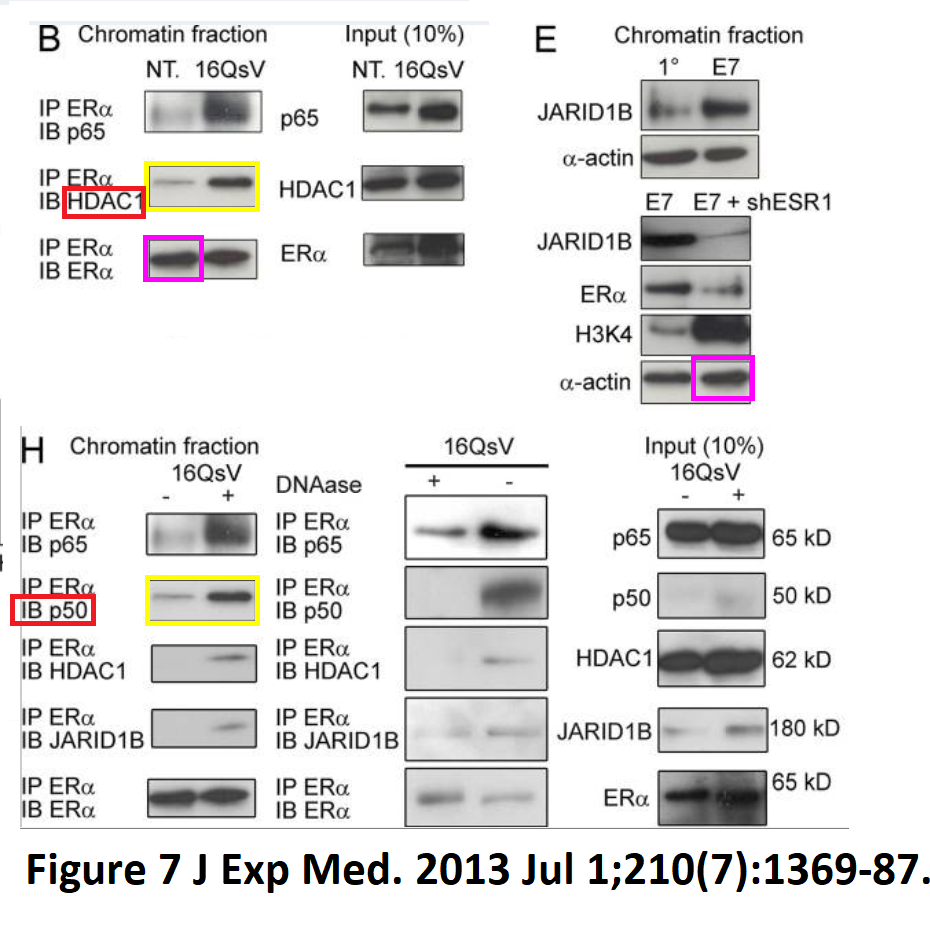
We now see how such creative approach to cancer research literally paid out for Hasan:
“This study was supported by the EMBO Fellowship Program (U.A. Hasan), La Ligue Régionale de la Loire contre le Cancer (U.A. Hasan), la Fondation pour la Recherche Médicale (U.A. Hasan), l’Association Research sur la Cancer (U.A. Hasan), and CLARA Procan Axe II innate sensors platform, Lyon (M. Tommasino)”.
The penultimate author is elite HHMI-funded researcher at Yale, USA, he is also thanked for his advice in several manuscripts by Hasan, Vlach and Tommasino. What will he say of such unconventional approach which as the authors assure, “may provide a novel therapeutic strategy for cervical cancers”?
I informed Merck and WHO Ethics team about those issues in August 2018. Merck replied that they “take such inquiries seriously” and are reviewing the information on Vlach’s publications which I sent them. From WHO, a request for more information arrived, because the PubPeer information was deemed insufficient as such:
“from the links you have posted, we can see the titles of a number of publications but it is difficult to assess what may have happened. We would need to know specifically which data may have been changed, in which publications, when and by whom.”
I replied immediately with explanatory examples, but have not heard from the WHO Ethics Team ever again. My recent two requests for an update went unanswered as of yet.
Update 3.12.2019
In November 2019, I wrote to WHO again. I received a reply: WHO expects PubPeer to remove slanderous evidence against their scientists who did absolutely NOTHING wrong.
This is the statement I received:
“Thank you for bringing your concerns to the attention of WHO. We have reviewed them and an investigation was undertaken into the matter.
The investigation looked at each allegation made and a rigorous approach was adopted further to the IARC Policy on Scientific Misconduct, as publicly available on the IARC internet site.
The allegations relate entirely to gel and blot “splicing”. This was and to a large extent still is common practice to reduce the size and complexity of figures which are illustrations derived from multiple experiments, and not intended to show the results of those individual experiments. Cell Press (http://crosstalk.cell.com/blog/common-pitfalls-in-figure-prepartion) say, “it is OK to remove irrelevant or blank lanes from a gel in order to present your data in a streamlined way to readers, but when you do it, you need to mark it clearly so that there is obvious transparency about how the figure was prepared” (2015). The Journal of Cell Science have suggested that “Any grouping or consolidation of data (e.g. removal of lanes from gels and blots or cropping of images) must be made apparent (i.e. with dividing lines or white spaces) and should be explicitly indicated in the figure legends.” (see http://jcs.biologists.org/sites/default/files/Revisionattachment_JCS.pdf )
It is noted that the splicing was not hidden deliberately, though on occasion it is noted it was less obvious in the printed figure and the figure legends did not always make the splicing clear. These minor errors are common in papers and should be avoided. The authors in question have been informed of what IARC expects and a policy on gels and blots from the Journal of Cell Science has been adopted.
Noting all this, the investigation:
- Found no evidence of scientific misconduct and concluded that the allegations made on PubPeer are not adequately supported and are therefore unfounded,
- Identified a small number of individual cases where errors in the figures require corrections, and
- Advised the authors to provide all available original data for the papers cited on PubPeer to the journal editors for their information.
Further to the above and in line with the IARC Policy on Scientific Misconduct and the investigation, it was determined that the matter could be closed.”

Donate!
If you are interested to support my work, you can leave here a small tip of $5. Or several of small tips, just increase the amount as you like (2x=€10; 5x=€25). Your generous patronage of my journalism will be most appreciated!
€5.00
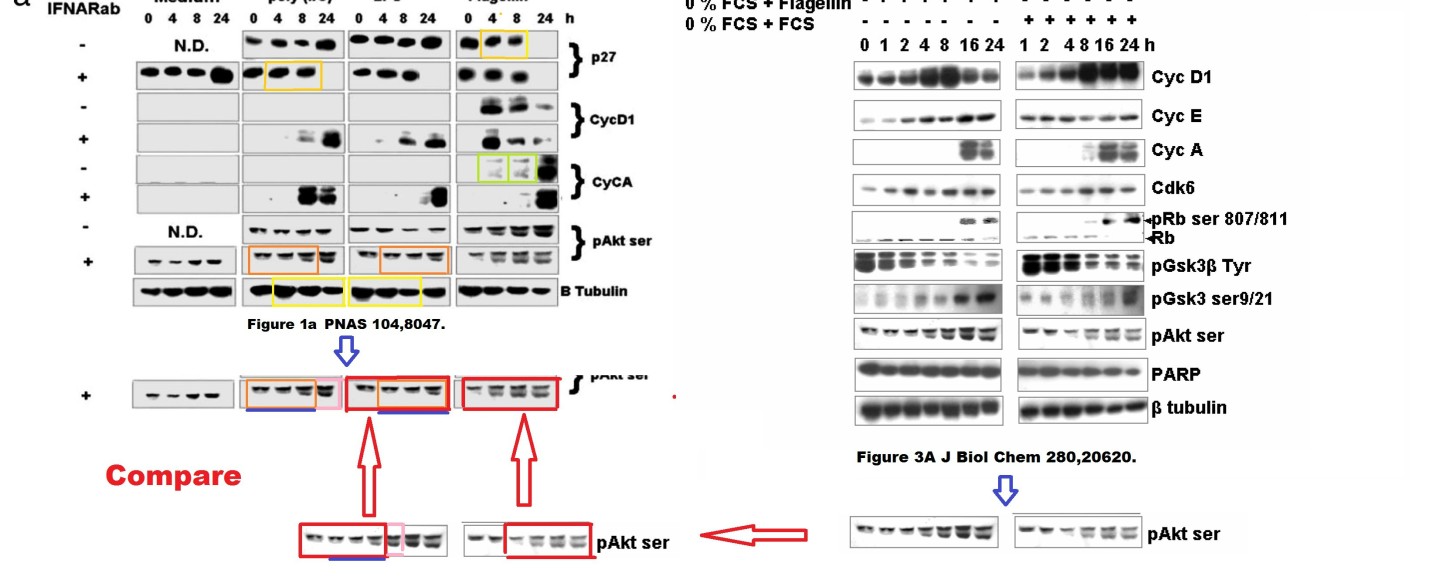

That’s shameful for WHO, in addition to the shame they crowned themselves by endorsing TCM.
LikeLiked by 1 person
These are the type of things that totally put an end of any truthful and truly useful cancer research other scientists may want to perform and let many patients keep dying of cancer and some donating their samples unfruitfulless
LikeLike
This is as bad as it can be! If WHO accepts research fraud, we have only God left to trust. Unfortunately I am not a Christian.
LikeLike
and there is no God in any event.
LikeLike
A chairman of the Governing Council has this to say.
http://www.iarc.fr/en/about/friendsofiarc.php
Dr Mark Palmer
Director of International Strategy, Medical Research Council, United Kingdom.
” It was a privilege to have chaired the Governing Council of IARC for four years. The work of the Agency is even more important now than when it was first established, and the continuing increase in the number of Participating States supporting the Agency demonstrates its global relevance and reach. ”
Lyon is known for its food, but did he look at any of the data?
Dr Mark Palmer is Director of International Strategy at the Medical Research Council (MRC). He has a degree in biochemistry from the University of Oxford, where he also completed his doctorate on the murine immune response to influenza. He has responsibility for MRC′s international policy and coordination of global health strategy.
Dr Palmer has served as Chairperson of the IARC Governing Council, Chair of the General Assembly of the European and Developing Countries Clinical Trials Partnership (EDCTP), Vice-President of the Board of Trustees of the Human Frontier Science Programme (HFSP), and Vice-President of the Korea–United Kingdom London Health Forum. He serves on the Governing Council of the European Molecular Biology Laboratory (EMBL) and the European Molecular Biology Conference (EMBC) and on the Board of ELIXIR. Dr Palmer is also the United Kingdom lead for Societal Challenge 1 (Health, Demographic Change and Wellbeing) of the European Commission′s Framework Programme Horizon 2020.
Is Mark Palmer the right man for all these jobs?
LikeLike
I vehemently disagree, MRC is very much the right people to cover for Tommasino and Hasan at IARC. They did an impressive work in enthusiastically endorsing every regenerative medicine circus freak show UCL et al choose to roll out, most notably Birchall’s cadaveric larynges and tracheas.
Now read this:
or this:
https://medicalxpress.com/news/2018-08-d-liver-tissue-implants-human.html
“Dr. Rob Buckle, Chief Science Officer at the MRC, commented: “This research brings us a step closer to harnessing the potential of stem cell ‘reprogramming’ technologies to provide renewable supplies of liver tissue products for transplantation.”
LikeLike
Pingback: Solidarietà femminili - Ocasapiens - Blog - Repubblica.it
If WHO supports all of these research misconduct I quite can understand now how has been so difficult for myself to move forward with my research as I have seen people with I work with making these type of data manipulations (and others) and
these people indeed keep being invited as keynote speakers for conferences
WHO has an enormous ethical responsibility and should consider taking adequate measures to solve this case and thus contribute to fair and clean research useful for all of us
Any of us can suffer of cancer or other serious illness….even the cheaters are not rid of it…will they test their cheated therapies on themselves eventually if they develop a cancer?
LikeLike
As was pointed out on the Twitterbox, Piero Anversa was still an honoured guest at the 2016 AHA meeting, long after everyone knew that his laboratory had operated as a fabrication factory.

LikeLike
Great, now I can’t get that ‘Frankengel, gel gel gel gel gel gel, gel gel Gel! Frankengel!’ song out of my head, sung in the tune of ‘Baby Shark’ after I started singing it to my child right after reading this post.
I already was sort of expecting to definitely die of my future cancer with the type of Frenkengels I keep seeing on websites like this for the last five years, but is there a way for them to pay for any mental hospitalization I might require from this Frankenshark fiasco?
LikeLike
Will it help you to read some fake nanotechnology by Smut Clyde? No gels there.
LikeLike
As an outsider to both fields (so my thinking might be wrong), the nano stuff is a welcome change, but it still is kind of weird to me how you need to copy and paste these particles since if you take enough pics, you just show one of them. Maybe some particle pictures where you need to show regularity, but some of those look like they were just too lazy to keep scanning. The gels seem to show a lot of thought and knowledge that the person doing the manipulating possesses. Like they are familiar with pathways and protein names, and are theoretically a good scientist. With nano-stuff, it’s so basic that I’m not so sure that the people faking data understand what they are doing. Oh well… That’s what happens when nano is the Latin word that means ‘funding’.
LikeLike
By the way I know an expert in gel manipulation, Hector Peinado
He already had to make corrections in two papers and has a couple of papers signaled at PubPeer for gel manipulations
Someone as mentioned in PubPeer warned CNIO about this without success
LikeLike
Honestly I think Hector Peinado should give good explanations about all of the gel manipulations (and other comments) which appear in PubPeer
A good opportunity for him to do this will be UKEV2018 conference at Sheffield on December 11, 2018 where he is invited as a keynote speaker
LikeLike
“From WHO, a request for more information arrived, because the PubPeer information was deemed insufficient as such:
“from the links you have posted, we can see the titles of a number of publications but it is difficult to assess what may have happened. We would need to know specifically which data may have been changed, in which publications, when and by whom.”
Members of WHO could take a look at the annotated images in Pubpeer, then check these against the original publications. Which people have changed data and when this happened is for members of WHO to figure out. Surely the WHO has a research integrity officer, who should be au fait with such matters?
LikeLike
You wrote Tommasino” in three different ways. I know that Italian double letters are a pain, but which one is correct? 😉
LikeLike
No I didn’t, it says correctly “Tommasino” everywhere!!!
Joking, thanks for pointing it out. One is always a bad editor if you proof-read your own texts. I corrected all now (I hope)
LikeLike
Reply to blatnoi October 15, 2018
“The gels seem to show a lot of thought and knowledge that the person doing the manipulating possesses. Like they are familiar with pathways and protein names, and are theoretically a good scientist.”
Akin to a religion: as long as you do not offend any of the central tenets you can publish. People can know how it should work by looking at papers, getting to know what what people in the field believe. You might make a reasoned guess at what should go up or down, even be correct in your guess, but no experiments are done.
LikeLike
And would you be happy with guesses and no experiments?
I submitted a complaint with some original data from the time I coincided with Hector Peinado at Cornell and these data does not have nothing to do with what was published….so their guesses are very poor
LikeLike
When you see image duplication it means that they do not have enough data to support their claims.
Being “clumsy” once or twice, but beyond that it wears thin as an excuse.
“And would you be happy with guesses and no experiments?”
I am not happy about it at all.
LikeLike
I am glad to hear that
I am exposing myself and telling my history and I hope this inspires other PhD students, postdocs, researchers not to stay silent and to denounce and to gather so that we can improve the uselfuness of science and and avoid wastage of resources
LikeLike
” and avoid wastage of resources”.
The saddest part of this is that scientists are displaced (unemployed) because such behaviour is either not detected, or if it is, nothing is done. At present image manipulation is rewarded. Much easier to make it up, more publications, more grants…more likely to valued by universities/institutions.
LikeLike
Massimo Tommasino is co-author. There are several pieces of problematic data.
PLoS One. 2012;7(5):e36909. doi: 10.1371/journal.pone.0036909. Epub 2012 May 16.
Interferon-β induces cellular senescence in cutaneous human papilloma virus-transformed human keratinocytes by affecting p53 transactivating activity.
Chiantore MV1, Vannucchi S, Accardi R, Tommasino M, Percario ZA, Vaccari G, Affabris E, Fiorucci G, Romeo G.
Author information
1
Department of Infectious, Parasitic and Immune-mediated Diseases, Istituto Superiore di Sanità, Rome, Italy.
Figure 6E.
Figure 6D.
LikeLike
Another Giovanna Romeo/Massimo Tommasino co-production.
J Cancer Res Clin Oncol. 2016 Aug;142(8):1751-63. doi: 10.1007/s00432-016-2189-1. Epub 2016 Jun 14.
Human papillomavirus E6 and E7 oncoproteins affect the expression of cancer-related microRNAs: additional evidence in HPV-induced tumorigenesis.
Chiantore MV1, Mangino G2, Iuliano M2, Zangrillo MS2, De Lillis I3, Vaccari G4, Accardi R5, Tommasino M5, Columba Cabezas S6, Federico M7, Fiorucci G3,8, Romeo G3,2,8.
Author information
1
Department of Infectious, Parasitic and Immune-mediated Diseases, Istituto Superiore di Sanità, 00161, Rome, Italy. mariavincenza.chiantore@iss.it.
2
Department of Medico-Surgical Sciences and Biotechnologies, Sapienza University of Rome, 04100, Latina, Italy.
3
Department of Infectious, Parasitic and Immune-mediated Diseases, Istituto Superiore di Sanità, 00161, Rome, Italy.
4
Department of Veterinary Public Health and Food Safety, Istituto Superiore di Sanità, 00161, Rome, Italy.
5
Infections and Cancer Biology Group, International Agency for Research on Cancer, 69372, Lyon, France.
6
Department of Cell Biology and Neurosciences, Istituto Superiore di Sanità, 00161, Rome, Italy.
7
National AIDS Center, Istituto Superiore di Sanità, 00161, Rome, Italy.
8
Institute of Molecular Biology and Pathology, Consiglio Nazionale delle Ricerche, 00161, Rome, Italy.
https://pubpeer.com/publications/DD9B9F8212398AB85858299126AC96
Figure 3E, thanks to Hoya Camphorifolia.
LikeLike
PLoS One. 2012;7(5):e36909 continued.
Figure 3.
LikeLike
Bit more problematic data figure 3 PLoS One. 2012;7(5):e36909.
LikeLike
Pingback: Científicos de la OMS usaron Photoshop para manipular imágenes en sus investigaciones - tuexperto.com
https://www.tuexperto.com/2018/10/18/cientificos-de-la-oms-usaron-photoshop-para-manipular-imagenes-en-sus-investigaciones/
LikeLike
I have sent an expression of concern to WHO and I will encourage all readers to do the same. Quite easy and you get an confirmation that they have received your message. You can also chose to be anonymous.
http://www.who.int/about/ethics/en/
An independent investigation is highly needed!
LikeLike
That PNAS paper of hers contains many other examples of Photoshop activities, like this Figure 5 here:
Some of the examples are so flagrant, they seem to be gestures of contempt.
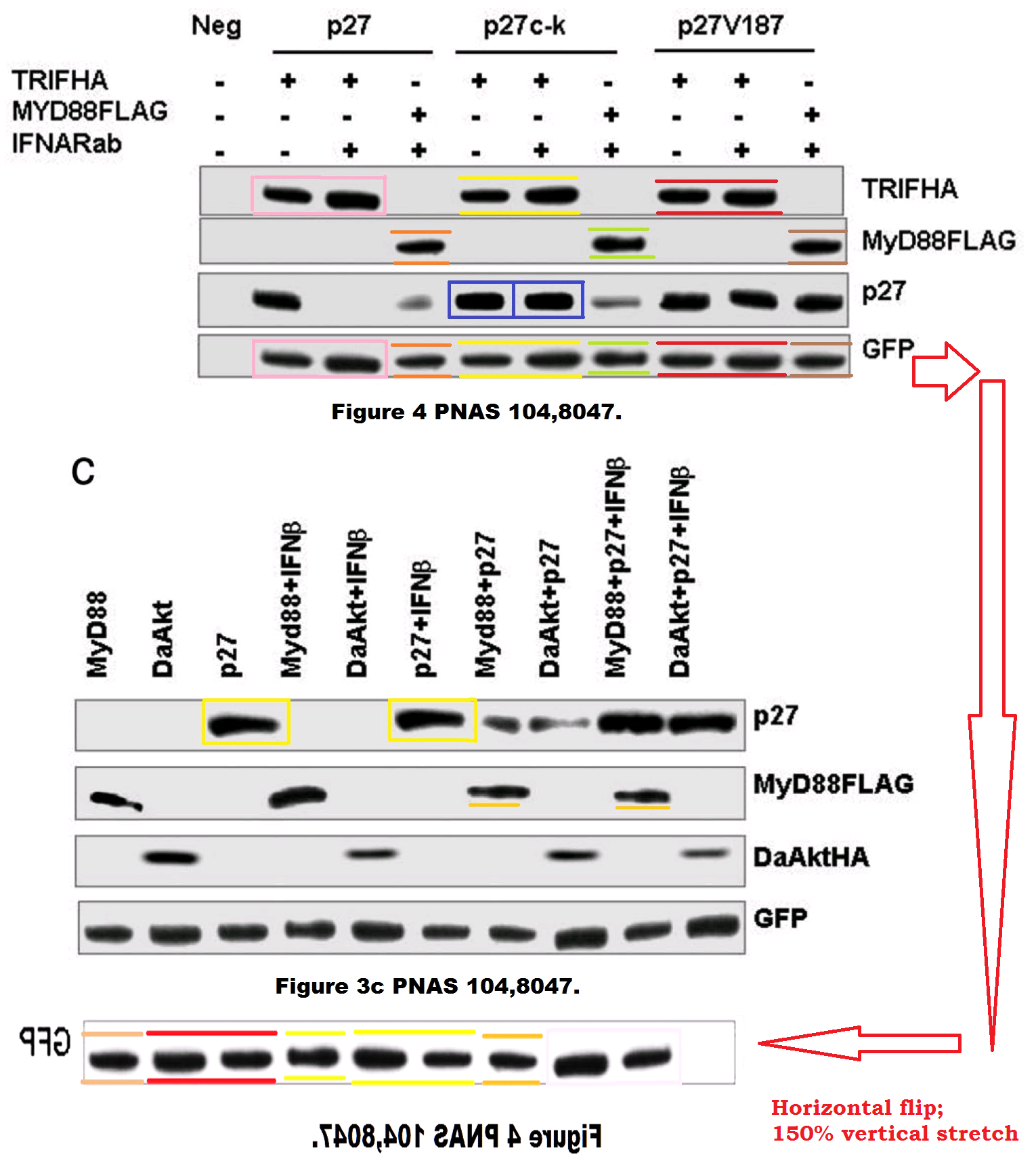
https://pubpeer.com/publications/7954D730B35DF13A053ACA5B301779#18
LikeLike
PNAS papers are as safe as houses. Notoriously difficult to get PNAS to shift anything.
“As for Dr. Croce’s work, the Proceedings of the National Academy of Sciences has reversed its stance.
After being contacted by The Times, the journal’s editor, Ms. Sullenberger, consulted with Dr. O’Brien at Berkeley and other analysts. The expert who in 2014 thought the duplication was unlikely, she said, now “accepts the new analyses because of their sophisticated nature.”
The journal, Ms. Sullenberger said, is now planning to issue a notice to readers about concerns regarding the WWOX paper.”
LikeLike
“Some of the examples are so flagrant, they seem to be gestures of contempt.”
Another interpretation is that they a plea for help!
LikeLike
PNAS, too big to fail? AJ Levine published his discovery of p53 two months after DP Lane.
Proc Natl Acad Sci U S A. 2007 Oct 16;104(42):16633-8. Epub 2007 Oct 5.
Declining p53 function in the aging process: a possible mechanism for the increased tumor incidence in older populations.
Feng Z1, Hu W, Teresky AK, Hernando E, Cordon-Cardo C, Levine AJ.
Author information
1
Cancer Institute of New Jersey, University of Medicine and Dentistry of New Jersey, New Brunswick, NJ 08903, USA.
https://pubpeer.com/publications/D927999EB49E5C74BD2BFA1861F7AF
LikeLike
Arnold Levine begat Moshe Oren.
https://pubpeer.com/search?q=moshe+oren
LikeLike
Levine’s output could be entertaining to examine in more detail.
LikeLike
Problematic papers Arnold J Levine here (many self-contributions to PNAS):-
Already mentioned,
https://pubpeer.com/publications/D927999EB49E5C74BD2BFA1861F7AF
More problematic publications
https://pubpeer.com/publications/D06844F99F3087CCF8EFA4986ED99B
https://pubpeer.com/publications/70FB838EB58E435B619CF0AB5D6B57
https://pubpeer.com/publications/DCF7CCC20997A71368E1DA7DEA19F6
https://pubpeer.com/publications/0C9309BDDF091E165990F63692B4E1
https://pubpeer.com/publications/3EBF11395DC4F262E38BB699DBF87D
https://pubpeer.com/publications/839F03109B8EAF7A67941CA3486EF8
https://pubpeer.com/publications/AB184C5E6E7F009ACD0EA2FD750840
https://pubpeer.com/publications/54D3BF6A339254AC3E7AA6AA8E19BC
https://pubpeer.com/publications/BF1B938FE587EEB92EAA321275A23D
LikeLike
That Pubpeer thread is still active and finding easter-eggs.
https://pubpeer.com/publications/D927999EB49E5C74BD2BFA1861F7AF#32
LikeLike
No wonder there are so many publications on p53, one of its discoverers has set the standard for image manipulation and the others follow.
Mature self-supporting religion, good at gathering funds from cancer charities (front organisations for members of their scientific advisory boards, e.g. prof Nick Lemoine sits of the scientific advisory board https://www.pancreaticcancer.org.uk/research/our-policies-advisory-board/scientific-advisory-board/ “Professor Nick Lemoine, Director of the Barts Cancer Institute, Barts and the London School of Medicine and Dentistry, University of London, UK”
and his institute receives funds from the same charity,
people know what to believe, don’t rock the boat.
Evidence of image duplication and reuse as different things by the aforementioned prof.
https://pubpeer.com/publications/E76D4CD96F41333C88C84A8EFBC57C
Does p53 really have all the functions claimed for it, or are some functions (changes in function) inventions of careerists?
For example “declining p53 function in the aging process [as] a possible mechanism for the increased tumour incidence in older populations” is a statement, which is not supported by the evidence.
https://pubpeer.com/publications/D927999EB49E5C74BD2BFA1861F7AF
LikeLike
Pingback: WHO Researchers 'Creatively' Used Photoshop To Doctor Cancer Images - New Investigation Reveals
https://www.acsh.org/news/2018/10/25/iarc-retraction-watch-begins-they-faked-images-controversial-claims-13532
“And some scientists who engage in public outreach are critical thinkers about studies everywhere, like molecular biologist Leonid Schneider and microbiologist Dr. Elisabeth Bik, who have called out groups who do this and also journal editors who enable them with a desire to publish provocative claims that will bring international media links.
A recent analysis of both journals and IARC involvement, titled WHO Cures Cancer In Photoshop, went into detail about the cultural flaws that allowed IARC to lose its way but more broadly about how easy it is to duplicate or reuse or slightly change graphics to look original in a science study. “
LikeLike
There is more in Fig 7 panel E. JARED1B (upper set) is reverese image of ERα (lower set). Very obvious! This activity hurts all of science and the perpetrators should be banished, including the ‘unobservant’ PIs.
LikeLike
LikeLike
Another leading member of the p53 crowd, who cannot spot problematic data in p53 ,or p73 papers for that matter.
https://forbetterscience.com/2017/09/21/carol-prives-innocent-victim-of-susana-gonzalez-data-manipulations/
Is it any wonder that people like Massimo Tommasino cannot spot problematic data in the same field?
LikeLike